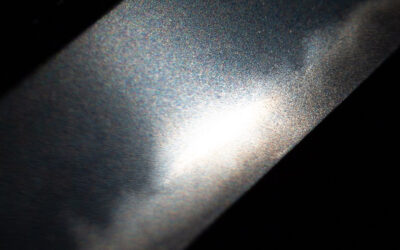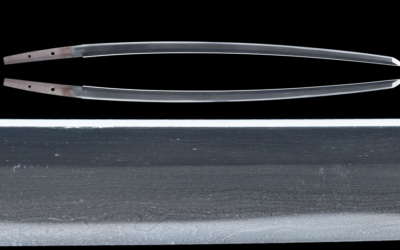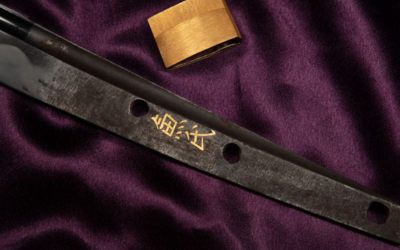

Project Info
Project Description
It is said that TAMETSUGU 為継 was either the son of GÔ YOSHIRO 郷義弘 of ETCHÛ, and that he later moved to NÔSHÛ FUWA-GÔRI, and according to one story, he was also a member of the NORISHIGE MON, but the NORISHIGE Monjin story is probably unreasonable from the standpoint of time. TAMETSUGU 為継 was called SHIRÔBEI, and it is said that his initial mei was inscribed as TAMETSUGU 為次, but have not seen a sword inscribed TAMETSUGU 為次.
As for YOSHIRO 義弘, who is said to be the father or the teacher of TAMETSUGU 為継, his personal history is unclear, but it is thought that he was the son of GOFUKU-GÔ NORISHIGE, and that he was a kaji of around KENMU (1334 – 1337), and in the works of TAMETSUGU 為継, there have been pieces seen with nenki of from ENBUN NINEN (1357) to ÔAN SHICHINEN (1374), and whether we are speaking of a father/son or teacher/student relationship of TAMETSUGU 為継 and YOSHIHIRO 義弘, neither is unreasonable from the standpoint of time.
However, since I have not seen a sword made by TAMETSUGU 為継 with a mei inscription showing that he is living in ETCHÛ, there is probably more research necessary in regard to the relationship between YOSHIHIRO 義弘 AND TAMETSGU 為継.
In regard to the area in which this sword was wrought, since “ ECHIZEN KUNI FUJIWARA TAMETSUGU, ENBUN NINEN HINOTO-TORI NIGATSU HI” (A day in the 2 nd Month of the year of the Cock, 1357) is inscribed, it is clear that he wrought swords from ENBUN NINEN (1357) to OAN NINEN (1369), but as to prior to ENBUN NINEN (1357), it is unclear whether he wrought swords in ECHIZEN, or whether he wrought swords in ETCHÛ in the Mon of YOSHIHIRO 義弘, since there are no swords wrought which clearly establish the region.
However, the possibility is very strong that, in ETCHÛ during the NANBOKUCHO period, YOSHIRO 義弘, whom was clearly divided from the UDA kaji that were thought to be kaji for the Southern Dynasty, was classified as a kaji on the Northern Dynasty side, and because of that, it is highly possible that the kaji of the YOSHIHIRO 義弘 Ke that were on the Northern Dynasty side fled to ECHIZEN due to the changes in the fortunes of war, and wrought swords there.
In regard to the period in which TAMETSUGU 為継 moved to MINO, since “NOSHU JU FUJIWARA TAMETSUGU, ÔAN SHICHINEN MINOE-TORA (remainder cut off) (Year of the Tiger, 1374) is inscribed on the naginata naoshi recorded in this taikan, it is clear that he moved from ECHIZEN to MINO sometime during the interval of from year two of ÔAN and year seven of that same period.
It is thought that perhaps, along with KUNIYUKI, in the interval of from around the autumn of ÔAN ROKUNEN (1373) to around the summer of ÔAN SHICHINEN (1374), he moved to MINO, and wrought swords in the vicinity of AKASAKA.
As for swords made by TAMETSUGU 為継, in regard to tachi, in the case of mumei swords that are judged to be by him, those with a typical Nabokuchô sugata in which the mihaba is wide and are ô-kissaki, are in the majority, but in signed swords, there are some in which there is a somewhat subdued sugata compared to that of the mumei swords that are assigned to him. For the mune, iori mune is the most common.
As for tantô, there are some which are muzori (no sori), and in which the mihaba and dimensions are ordinary, there are also some which are larger having a wide mihaba and a shallow sori, and there are also hirazukuri ko-wakizashi. As for the mune, different than in the tachi, mitsu mune is the most common. As for the jitetsu (jigane), there are some that are hadatachi in which masame is mixed in itame, there are some that are very tightly wrought in which mokume is mixed in itame, and in either case ji-nie appears. In particular, in mumei works, there are some in which chikei conspicuously appears in an uzumaki hada resembling that of the matsugawa (pine bark) hada of NORISHIGE.
As for traits that are common throughout to both zaimei and mumei, the fact that the jitetsu is blackish, and the fact that the nioi guchi is subdued, are the most common, and rather than saying that these traits are common to TAMETSUGU 為継, these are also common in general throughout the Nanbokumono (works of the Nanbokucho period).
As for the hamon, the most common are a shallow notare or a small pattern gunome (gunome) in a ko-nie deki suguba tone, and there are also some that become a kata-ochi gonome in which the heads of the gonome are aligned. Rarely, there is one that is suguba in which a slight notare is mixed. There are also instances of yubashiri in which there is sunagashi with nie.
As for the bôshi, there are some in which it is midare and hakkake, there are some that are suguba and hotsure (crumbling), in either case the return is shallow, but there are a very few with a deep return.
For horimono, in tachi, there are pieces with bôhi and futasuji hi, and in tantô and wakizashi there are pieces in which Bonji, rendai, and ken are engraved.
In regard to the nakago, there are pieces in which the saki has an elongated flavor, and there are some in which the saki has a narrowed flavor, and the nakago jiri is a ha-aari kurijiri. In tantô it is short with a swollen belly, and the nakago jiri is the same as in tachi, being a ha-agari kurijiri. Since there are pieces in which it is finished in a SENSHUIN KE kaji characteristic trait in which the hiraji ji is katte sagari and the shinogi ji is sujigai, perhaps TAMETSUGU 為継 and YOSHIHIRO 義弘 are kaji that came from the YAMATO SENSHUIN KE. Among the mei, there are “ESSHÛ JÛ FUJIWARA TAMETSUGU,” ECHIZEN NO KUNI FUJIWARA TAMETSUGU,” NÔSHÛ JÛ FUJIWARA TAMETSUGU,” “FUJIWARA TAMETSUGU SAKU,” “TAMETSUGU SAKU,” AND “TAMETSUGU.”
Juyo Etchu Tametsugu katana
DESIGNATED 5 October 2000
46th JUYÔ TÔKEN SHINSA
KATANA
Mumei: TAMETSUGU . Owner: Aoyama Junkichi (⻘⼭順吉), Tōkyō-to
Dimensions:
– Length 67.8 cm
– sori 2.0 cm
– motohaba 3.2 cm
– sakihaba 2.5 cm
– kissaki length 6.2 cm
– nakago length 18.6 cm
– nakago 0.1 cm
Keijó: Shinogi zukuri, mitsu mune, wide mihaba, difference slight between motoniiba and sakihaba, with a deep sori, ó-kissaki,
Kitae: Moku(me) mixed in itame, with abundant ji-nie, chikei frequently inserted.
Hamon: Gonome mixed in a basic tone of notare, with ko-ushi, abundant nie, sunagashi copiously ap-plied, with kinsuji, niới-guchi tending to be shizumi (subdued).
Böshi: Midarekomi, saki returns in ko-maru.
Horimono: Futasujihi ure kakinagasu on the omote and ura.
Nakago: Õ-suringo, saki is kiri, yasurime is sujikai, 2 mekugi ana, mumei.
Explanation:
TAMETSUGU, according to commonly held opinion, is the son of GO YOSHIHIRO and it is said that his teacher was NORISHIGE, but from the aspect of time frames, there is probably room for more research. Due to the fact that in his works oshigata with a mei of ECHIZEN NO KUNI FUJIWARA TAMETSUGU and nenki of ENBUN NINEN (1357) and OAN NINEN (1369) can be seen, and because there is an example work with a mei of NOSHÚ JŨ FUJIWARA TAMETSUGU with a nenki of OAN SHICHINEN (1375) on an extant sword he made, it can be seen that sometime between OAN NINEN (1369) and OAN SHICHINEN (1375ND) he moved from ECHIZEN to MINO .His works exhibit a kitae of itame that is hadatachi, and as for the hamon, there is midareba in a basic notare tone, gonome midare, ko-notare mixed in gunome, and the like, and common examples have hotsure in the habuchi, abundant nie, and a fairly subdued (shizumi) nioi-guchi.
This katana has a construction with a wide body and o-kissaki, shows the shape of the Nanbokuchő Jidai, specifically the period of from ENBUN (1356-1361 ND) to JOJI (1362-1368 ND), the kitae is mokume mixed in itame, with thick ji-nie, chikei is frequently inserted, and the condition of the steel showing a blackness especially provides a clue pointing to KITAKUNI (Northern Province) work. Also, the hamon exhibits a gunome mixed in a basic tone of notare, with copious nie, frequent sunagashi and kinsuji, a fairly subdued nioi-guchi, and the characteristics of TAMETSUGU notice-ably appear. This is a piece that is rich in changes in the yakiba, the workmanship is excellent, and the fact the ji and ha are both healthy throughout is also appealing.




